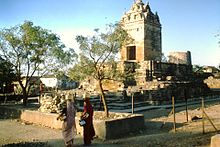Gop Temple
| Gop Temple | |
|---|---|
ગોપનું મંદિર | |
 6th century Sun temple | |
| Religion | |
| Affiliation | Hinduism |
| District | Jamnagar district |
| Deity | Surya, Skanda, others[1] |
| Location | |
| Location | Zinavari village, Jamjodhpur Taluka |
| State | Gujarat |
| Country | India |
| Geographic coordinates | 22°1′43″N 69°55′44″E / 22.02861°N 69.92889°E |
| Architecture | |
| Style | Hindu temple architecture |
| Completed | 6th century CE[2] |
The Gop temple is a Sun temple located at Zinavari village in Jamjodhpur Taluka of Jamnagar district, Gujarat, India. The Hindu temple is dated to the 6th century and is one of the earliest surviving stone temples in Gujarat.[2][3] The original temple had a square plan, a mandapa and covered circumambulation passage which are lost, and a pyramidal masonry roof which is ruined but whose partial remains have survived.[2] The temple has a height of 23 feet (7.0 m) which includes a small tower. The roof of the tower is decorated with arch-like gavaksha window shapes below an amalaka cogged wheel-shaped crown.
Location
It is located on the bank of Vartu river and south-west of the Gop hill of Barda Hills. The Zinavari village is also known as Juna or Nana Gop and is located east of Gop village. It is located north of Ghumli, on a hill top.[4][3]
History
The ancient temple of Gop is considered the earliest surviving stone temple of
K. V. Soundara Rajan assigned the first half of the 7th century.
Description

The temple has a square plan to which were added bricked double courtyards centuries later. The temple was bigger and included a mandapa and a roofed pradakshina-patha (circumambulation passage), but most of it was damaged and has fallen away leaving a peculiar looking skeletal structure. The sanctum walls remain standing and parts above the shikhara.[A] The shrine is 10 feet 9 inches square from inside. It is 23 feet high and has 2 feet 6 inches thick walls. The walls are plain without any ornamentation and perpendicular to height till 17 feet and over it survives the pyramidal shikhara. Each course is about 8 inches deep and is jointed. Thus it is built from stones without any kind of cement. At 11 feet from the floor, there are four holes in the front and back walls, each 14 inches high, probably for joists; and over them, in side walls, are six smaller holes, probably for rafters. The sanctum faces the east. Its front wall fell and seems rebuilt at someone with the inner sides of the stones turned out, showing the sockets of the clamps with which the stones had been secured. There is an inscription on the left jamb of the door which Burgess was unable to decipher.[4][10]


The shikhara (spire) is formed by six or seven courses having beveled edges followed by square faces and at last the apex covered by single slab. It follows corbel principle, the interior is hollow. From outside, it rises in tiers having three clear divisions. The lowest division has two gavakshas or arch-shaped motifs on each side, with some images carved in. The apex is crowned by a single stone amalaka (stone disc) on it. Some figures on the Shikhara are identifiable. There is a Ganesha figure still visible in the west side and another Deva figure on the north side. There are a series of holes 21⁄2 feet below the string-course which supported beams that once supported the roof of inner courtyard.[4][10][11]
Of the two courtyards, the inner courtyard is mostly broken. It was 35 feet 2 inches square with bay on the east side 18 feet 4 inches by 7 feet 3 inches. It may have served as parikrama path so it is sandhara (with circumambulatory path) type of temple. The basement of it was decorated on all four sides by one niche in the centre and one each at the corners. These are empty, but likely had sculptures inside. The stretch between these niches was ornamented with small figures such as dwarfs. The outer courtyard was about 91⁄2 feet wide. It was probably open above or at least laterally.[4][10]
There are two figures of deities in yellow stone inside the shrine. It can not be decided who are they exactly. They are locally known as
Influences and resemblances
The temple is an unusual architectural variation on the Nagara style. It has resemblances with early Dravidian temples of
Notes and references
Notes
References
- ISBN 90-04-06941-0.
- ^ ISBN 90-04-05666-1.
- ^ ISBN 978-1-317-19374-6.; Quote: "The earliest image in the region can be dated to the fourth century CE and a worn out figure at the temple of Gop dates to between 525 and 550 CE".
- ^ a b c d e f g h i James Burgess (1876). Report on the Antiquities of Kutch & Kathiawar: Being the Result of the Second Season's Operations of the Archaeological Survey of Western India, 1874-1875. London: India Museum. p. 187. Retrieved 27 August 2016.
Alt URL Archived 2016-08-29 at the Wayback Machine This article incorporates text from this source, which is in the public domain.
This article incorporates text from this source, which is in the public domain. - ^ Hasmukh Dhirajlal Sankalia (1941). The Archaeology of Gujarat: Including Kathiawar. Natwarlal & Company. pp. 55–59.[permanent dead link] Alt URL Archived 2017-08-03 at the Wayback Machine
- ISBN 978-0-391-02284-3.
- ^ K. V. Soundara Rajan (1980). A Note on the Age of Gop Temple in Glimpses of Indian Culture: History & Archaeology. Sundeep. pp. 196–199.
- ISBN 90-04-03691-1.
- ^ Sompura, Kantilal F. (1968). The Structural Temples of Gujarat, Upto 1600 A.D. Gujarat University. pp. 75–76.
- ^ ISBN 90-04-05666-1.
- ^ Kallidaikurichi Aiyah Nilakanta Sastri (1982). A Comprehensive History of India: pt. 1-2. A.D. 300-985. Orient Longmans. pp. 1156–1158.
- ^ Prithvi Kumar Agrawala (1968). Gupta temple architecture. Prithivi Prakashan. p. 57.






